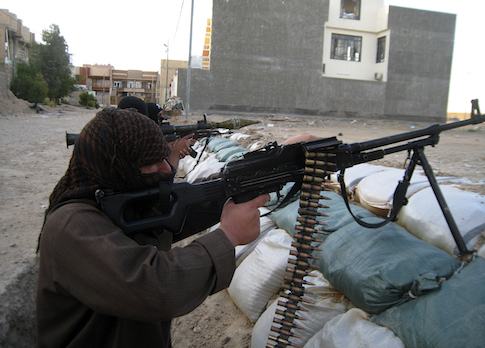The Obama administration never actually defined what the al Qaeda terrorist group is before declaring that it was on the path to defeat, according to a new report that says the group now has its largest-ever global presence.
The report from Mary Habeck, a visiting scholar at the American Enterprise Institute (AEI) and author of numerous books on al Qaeda, argues that the administration’s vague definition of the terrorist group has hampered America’s response to its global threat.
President Barack Obama’s "National Strategy for Counterterrorism," released in June 2011, divided al Qaeda into three parts: its "core leadership in Afghanistan and Pakistan," its "affiliates," and its "adherents." While never fully explaining what it meant by "core," the strategy stated in a footnote that affiliates included groups and individuals whom the United States is not authorized to use force against.
Adherents included individuals who engage in violence to further the goals of al Qaeda, "regardless of whether such violence is targeted at the United States, its citizens, or its interests."
Habeck said the administration’s strategy implied such a narrow view of al Qaeda that it only permitted attacks against groups and individuals who planned, committed, or aided the Sep. 11, 2001, terrorist attacks. That policy is virtually the same as the 2001 Authorization for the Use of Military Force (AUMF).
However, many of those originally tied to the attacks have been killed through military engagement or drone strikes. "People have not been added to this list," Habeck said at an AEI event, adding that al Qaeda has since replaced its leaders and expanded its affiliates.
Al Qaeda now has active insurgencies in nine countries compared to just three in 2011, according to the report, with the latest arising in Syria and Iraq. Affiliates that do not directly interact with al Qaeda’s core leadership still endorse its goals and threaten U.S. interests, Habeck said.
"It doesn’t matter whether you have command and control behind these groups with this specific ideology, because they’re committed to the same objectives," she said. "It will cause precisely the same amount of damage whether or not there’s command and control from the core."
Al Qaeda’s stated goals often do not mention the United States, she said. While the group and its affiliates aim to expel all U.S. forces from the Middle East, they also seek to impose an extremist vision of sharia law on unwilling Muslims, overthrow secular leaders, and establish a new caliphate.
Al Qaeda publicly broke with the Islamic State of Iraq and Syria (ISIS) group in February in favor of the Jabhat al-Nusra affiliate in Syria. However, both groups have served to advance al Qaeda’s ideology and some of its goals in addition to destabilizing Iraq, Syria, and the surrounding region.
They also pose a security threat to the West.
There are as many as 7,000 Sunni foreign fighters battling President Bashar al-Assad’s forces in Syria, according to one study by an Israeli intelligence center. More than 1,000 came from Western Europe and a few dozen from the United States and Canada. Western officials fear that they could one day return home to conduct attacks.
Fred Kagan, director of AEI’s Critical Threats Project and one of the architects of the "surge" strategy in Iraq, sharply criticized the Obama administration for creating "by policy the largest sanctuary for al Qaeda that the group has ever known in Iraq and Syria."
He said the administration’s refusal to conduct targeted air strikes in either country has failed to address both the humanitarian and strategic crises in the region. About 150,000 people have been killed in the Syrian conflict, and nine million Syrians have been driven from their homes.
"We are seeing that in addition to the fact that those policies are, in my opinion, morally reprehensible and indefensible, they are bad strategy," he said. "The conflicts themselves and the atrocities and radicalized populations become magnets for radicalization and become laboratories for experimentation by the enemy that are in fact dangerous."
The Obama administration has continued to claim that "core" al Qaeda is "on the run." Obama told the New Yorker in a recent interview that "if a JV team puts on Lakers uniforms that doesn’t make them Kobe Bryant," a reference to al Qaeda affiliates that he said are "engaged in various local power struggles and disputes."
Katherine Zimmerman, a senior analyst at AEI’s Critical Threats Project, said the administration has yet to "fight the entire al Qaeda network as a whole."
That includes not just military action, but also helping countries to improve their police forces and political governance, she said.
"We’ve been playing this game of whack-a-mole for the last 13 years, and we’re going to continue to play it if we just fight the groups that pop their heads up."
